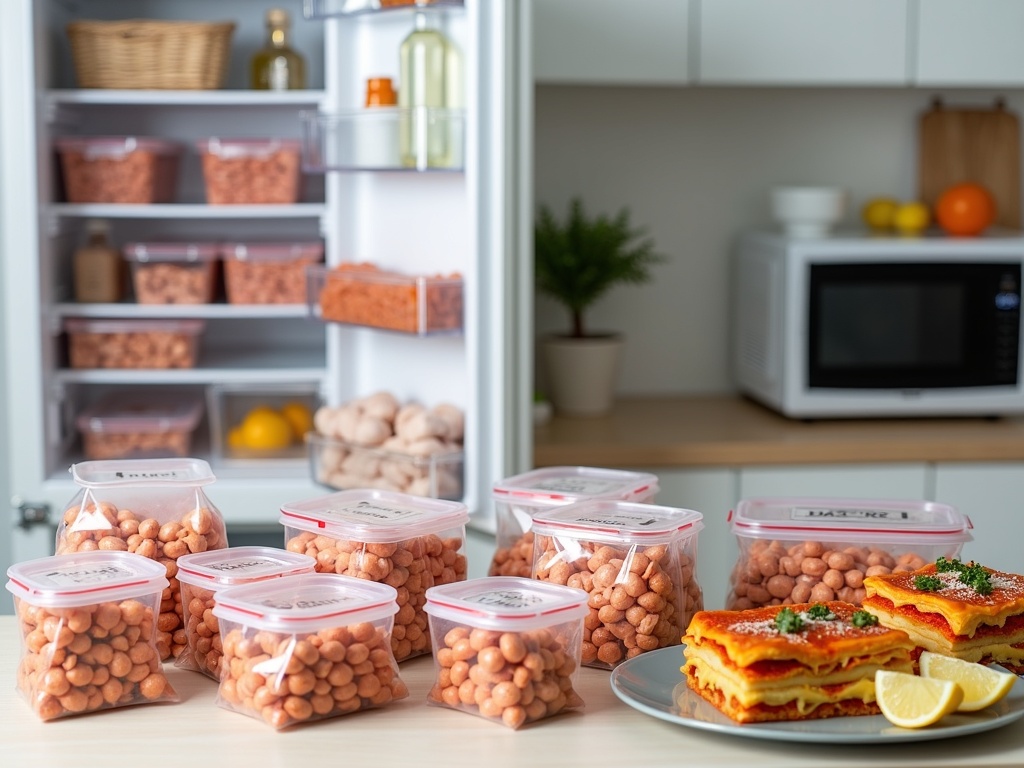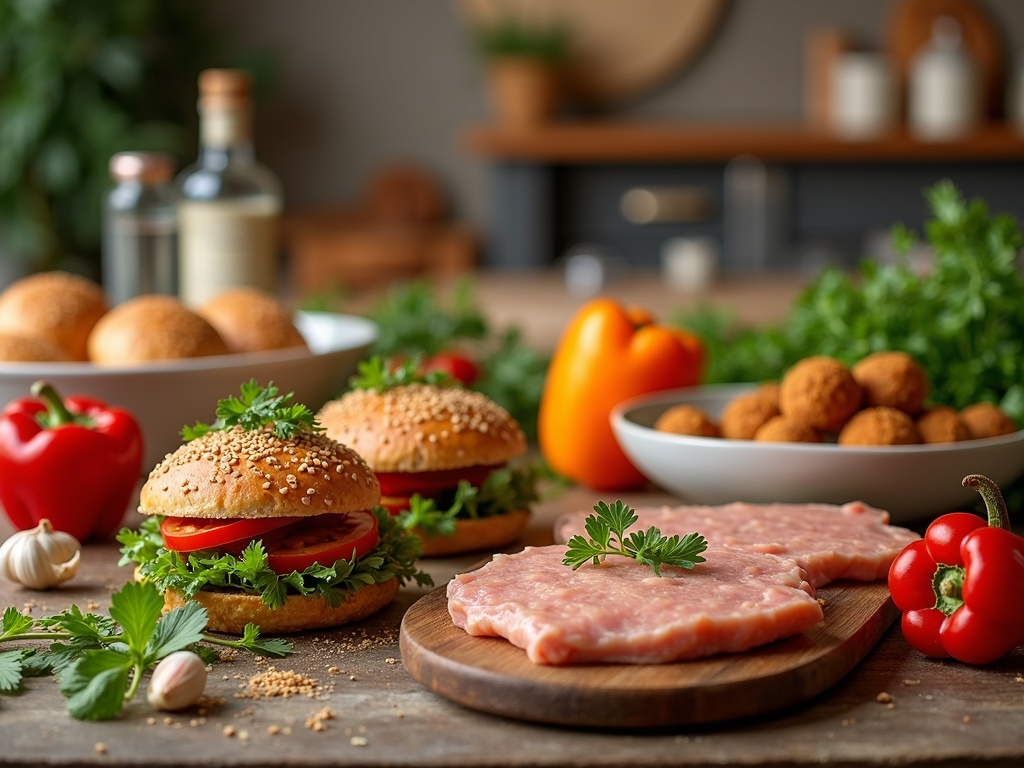Chicken mince recipes strike a balance between nutrition and versatility, serving as a lean protein powerhouse that can be incorporated into countless recipes. From homemade burgers to meatballs or global dishes, this affordable protein delivers health benefits while being quick to prepare and cost-effective.
Find In This Article
Key Takeaways
- Chicken mince contains 20-25 grams of protein per 100 grams with only 10% fat, making it significantly leaner than beef mince with 25% fat.
- Versatile in the kitchen, chicken mince works perfectly in burgers, meatballs, stuffings, stir-fries, and comfort food classics like lasagna.
- Properly stored chicken mince lasts 1-2 days in the refrigerator and 2-3 months in the freezer, making it ideal for meal prepping.
- At $3-5 per pound, chicken mince is more economical than beef alternatives while providing comparable protein content.
- Chicken mince adapts well to various dietary needs including low-carb, keto, and calorie-controlled eating plans.
Understanding Chicken Mince: A Lean Protein Powerhouse
Chicken mince, also known as ground chicken, has become my go-to protein source when I’m looking for something nutritious yet versatile in the kitchen. This finely ground chicken meat packs an impressive nutritional punch while remaining adaptable enough for countless recipes.
Nutritional Benefits
Chicken mince delivers an impressive 20-25 grams of protein per 100 grams, making it an excellent option for muscle maintenance and growth. I’ve found it particularly useful for high-protein meals without the heaviness of red meat. What really sets it apart is its fat content – chicken mince contains around 10% fat compared to beef mince’s 25%, making it a leaner choice for health-conscious cooking.
The lean profile doesn’t mean sacrificing flavor, though. Ground poultry options like chicken mince provide a neutral base that readily absorbs seasonings and spices, allowing for creative and flavorful dishes without excessive calories.
Cooking Versatility
I’m constantly amazed by how many different meals I can create with this single ingredient. Here are some popular ways to use chicken mince:
- Burger patties: Mix with herbs and spices for delicious homemade burgers that are lighter than traditional beef versions
- Meatballs: Perfect for pasta dishes or as appetizers with dipping sauces
- Stuffings: Ideal for vegetables, pastries, or even traditional holiday dishes
- Asian-inspired dishes: Works beautifully in stir-fries, dumplings, and lettuce wraps
- Comfort food classics: Great in chicken lasagna or shepherd’s pie for a lighter twist
The quick cooking time is another advantage – chicken mince cooks through in minutes, making it perfect for busy weeknights. I’ve discovered that chicken recipes using mince are typically faster than those using whole cuts.
For those seeking alternatives to beef, mince recipes using chicken offer a fantastic option that’s both nutritious and budget-friendly. I’ve even experimented with smash burger techniques using chicken mince for a unique twist on this popular cooking method.
Whether you’re meal prepping for the week or cooking for a family dinner, chicken mince delivers protein-packed versatility that adapts to countless culinary traditions and dietary needs.

Must-Try Chicken Mince Recipes
Chicken mince is a fantastic protein option that’s lean, versatile, and perfect for quick meals. I’ve found that chicken mince recipes offer endless possibilities while keeping calorie counts reasonable. Let me share some tried-and-tested favorites that have become staples in my kitchen.
Family-Friendly Chicken Mince Dishes
Chicken tacos make an excellent weeknight dinner. I mix chicken mince with cumin and chili powder, then brown it until it reaches the essential 165°F internal temperature for safety. Two loaded tacos typically contain between 300-400 calories, making them a balanced meal option.
For a classic favorite, homemade chicken burgers are hard to beat. I combine the mince with finely diced onions and breadcrumbs, then shape them into patties. Each burger comes in at just 200-300 calories, especially when served with a side salad instead of fries.
Baked chicken meatballs have become my go-to for meal prep. Mixing the mince with fresh garlic and chopped parsley before baking creates flavorful meatballs that contain approximately 250 calories per four meatballs. These are perfect for throwing into chicken lasagna or serving with whole grain pasta.
Quick Tips for Better Chicken Mince
I’ve discovered that chicken mince needs careful handling to bring out its best qualities. Here are my essential tips for working with this versatile protein:
- Always sauté garlic and onions before adding your chicken mince – this simple step makes a huge difference to the depth of flavor.
- Cook chicken mince thoroughly to 165°F using a meat thermometer for safety.
- Add vegetables like bell peppers and broccoli to create a balanced stir-fry that’s only 250-350 calories per serving.
- Mix a tablespoon of ricotta into burger patties for extra moisture.
- Avoid overworking the mince when making burger patties to keep them tender.
Chicken mince works brilliantly in almost any recipe that calls for traditional mince. I’ve even created a Mediterranean-inspired bowl combining chicken mince with cucumber, tomatoes, and a light yogurt dressing that’s become a summer favorite. When you’re looking for simple chicken recipes that offer maximum flavor with minimum fuss, chicken mince should be top of your list.
Health and Nutrition Benefits
Chicken mince delivers exceptional nutritional value while offering remarkable versatility in the kitchen. I’ve found it to be a protein powerhouse that supports muscle development without the higher fat content of other ground meats.
Protein-Rich Properties
The high protein content in chicken mince makes it a stellar choice for anyone focusing on muscle growth and repair. A typical 100g serving provides approximately 20-25g of protein, making significant progress toward daily requirements. The Recommended Daily Allowance (RDA) for protein stands at 46 grams for women and 56 grams for men, meaning a single chicken mince meal can supply nearly half your daily needs.
Protein isn’t just for bodybuilders – it’s essential for:
- Cell repair and maintenance
- Hormone and enzyme production
- Immune system function
- Feeling satisfied after meals
What makes chicken mince particularly valuable is its lean profile. Compared to beef or lamb mince, chicken mince contains significantly fewer calories and less saturated fat while delivering comparable protein. This makes it perfect for creating nutritious homemade burgers or adding to everyday dishes.
Dietary Adaptability
I’ve incorporated chicken mince into countless dietary approaches with great success. Its neutral flavor profile makes it ideal for absorbing various seasonings and spices. For those following specific eating patterns, chicken mince offers remarkable flexibility:
Low-carb and keto dieters appreciate that chicken mince contains virtually zero carbohydrates while providing satisfying protein. The lean nature of chicken mince also makes it perfect for calorie-controlled eating plans without sacrificing flavor or texture.
Many fitness enthusiasts turn to turkey mince recipes for their lean protein, but chicken mince delivers similar benefits with often more moisture and flavor. For increased variety, I regularly alternate between these poultry options.
The adaptability of chicken mince extends to different global cuisines. From Italian-inspired chicken lasagna to Asian-style lettuce wraps or Middle Eastern koftas, chicken mince works beautifully across culinary traditions. This versatility makes it easier to maintain healthy eating habits without meal monotony.
For those looking to reduce red meat consumption without eliminating meat entirely, chicken mince provides an excellent transition option. It works in virtually any recipe calling for ground meat, from traditional mince recipes to more creative applications.
Chicken mince also offers important micronutrients, including B vitamins crucial for energy production and metabolism. Niacin (B3), in particular, is abundant in chicken and supports cellular function throughout the body.
For quick weeknight meals, I often prepare simple chicken recipes using mince instead of whole pieces. The faster cooking time means less kitchen stress while still delivering excellent nutrition.
Those seeking to create healthier versions of fast food favorites find chicken mince invaluable. Lighter smash burger recipes made with chicken mince provide the satisfaction of comfort food with improved nutritional value.
The ability to portion and freeze chicken mince also helps with meal planning and portion control – key factors in maintaining healthy eating patterns. I often prepare larger batches of chicken mince dishes, dividing them into appropriately sized portions for convenient future meals.
Smart Storage and Meal Prep Solutions
Chicken mince offers incredible versatility in the kitchen, but knowing how to store it properly can extend its shelf life and preserve its quality. I’ve learned that fresh chicken mince recipes rely on proper storage techniques to maintain flavor and food safety.
Refrigeration and Freezing Guidelines
Fresh chicken mince is highly perishable and should be used within 1-2 days when stored in the refrigerator. I always keep it in the coldest part of my fridge, usually at the back of the bottom shelf. To maximize freshness, I leave the mince in its original packaging until ready to use or transfer it to an airtight container.
For longer storage, freezing is the best option. Properly stored chicken mince can last in the freezer for 2-3 months, though I’ve found it’s best used within the first month for optimal quality. When freezing, I divide the mince into portion-sized packages using freezer bags or containers, pressing out as much air as possible before sealing.
Batch Cooking and Meal Prep Ideas
Chicken mince is ideal for bulk cooking and portioning, making it perfect for meal prep enthusiasts. I typically dedicate an hour on weekends to prepare multiple chicken mince meals that can be frozen and enjoyed throughout the week. Some freeze-friendly dishes I regularly prepare include:
- Chicken meatballs that can be added to pasta, sandwiches, or eaten alone
- Chicken lasagna portioned into individual servings
- Stuffed peppers with seasoned chicken mince filling
- Mince-based sauces for quick pasta dinners
- Homemade chicken burgers similar to smash burgers but with chicken
Before freezing cooked dishes, I always allow them to cool completely. This prevents condensation inside containers that can lead to freezer burn. Labeling each container with the contents and date helps track freshness.
For raw chicken mince, I’ve found that marinating before cooking helps retain moisture after thawing. A simple mixture of olive oil, lemon juice, and herbs works wonders. The acidic component breaks down proteins slightly, resulting in more tender cooked mince.
When it’s time to defrost, I transfer frozen mince from the freezer to the refrigerator the night before cooking. For quicker defrosting in a pinch, the defrost setting on a microwave works well, though I’m careful to cook the mince immediately afterward.

Budget-Friendly Cooking Guide
Chicken mince stands as one of the most economical protein sources available in today’s grocery market. I’ve found that chicken mince typically ranges from $3-5 per pound, making it significantly more affordable than many other protein options. This price point has made it my go-to ingredient when I’m looking to create delicious tasty mince dishes without breaking the bank.
Cost Comparison and Savings
When compared to other mince varieties, chicken mince offers remarkable value. It’s consistently more economical than beef alternatives, which often cost $5-7 per pound for even the most basic varieties. The savings become even more apparent when preparing family-sized meals or batch cooking for the week ahead.
The economical nature of chicken mince makes it perfect for creating budget-friendly versions of traditionally expensive dishes. I’ve transformed costly recipes into affordable options by substituting chicken mince in classics like chicken lasagna recipes that usually call for more expensive meats.
For even greater savings, consider these strategies:
- Bulk purchasing when prices drop can reduce your per-pound cost by up to 20%
- Freezing portions in meal-sized quantities extends shelf life without sacrificing quality
- Shopping at wholesale clubs often yields significant discounts on family-sized packages
- Looking for weekly specials at grocery stores can help you stock up at the lowest prices
Smart Shopping Strategies
I’ve discovered that sourcing chicken mince directly from local farms or butchers can sometimes offer surprising cost advantages. Many local producers sell their products at competitive rates while delivering superior freshness and quality. This approach not only supports local businesses but can also result in better-tasting dishes like homemade burger recipes that showcase the quality of the ingredients.
Another effective strategy involves planning meals around versatile ingredients. Chicken mince excels in this area, as a single package can form the protein base for multiple distinct meals. From simple chicken recipes like meatballs and patties to more complex options like stuffed vegetables or dumplings, one purchase stretches across several days of meals.
The freezer-friendly nature of chicken mince adds another dimension to its economical appeal. I often purchase larger quantities when on sale, portion them into meal-sized packages, and freeze for later use. This approach ensures I always have the foundation for quick meals like smash burger recipes ready to go, preventing last-minute takeout expenses.
For those looking to maximize their food budget, chicken mince also pairs exceptionally well with cost-effective ingredients like pasta, rice, and seasonal vegetables. These combinations create filling, nutritious meals at a fraction of the cost of restaurant alternatives. Even turkey mince recipes tend to be more expensive while offering similar nutritional profiles.
Meal planning becomes significantly more affordable when centered around chicken mince. A single pound can typically yield 3-4 servings, bringing the protein cost per meal down to approximately $1-1.50 per person. This efficiency makes chicken mince an unbeatable choice for budget-conscious home cooks who refuse to compromise on flavor or nutrition.

Sources:
USDA Nutrient Database
USDA Guidelines for Poultry
Nutrition Journal – “Healthy Protein Choices”
Clean Eating Magazine – “Meal Prep for the Week”

